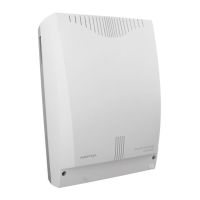Ascotel IntelliGate 2025/2045/2065
180 Identification Elements Part 2
Fig. 2.9: CLIP and CNIP
When the destination subscriber answers the call, the number or name of the des-
tination subscriber is transmitted and displayed to the caller:
• The indication of the number is referred to as COLP (Connected Line Presenta-
tion).
• The indication of the name is referred to as CONP (Connected Name Presenta-
tion).
Fig. 2.10: COLP and CONP
These identification elements allow the use of other features such as logging
unanswered calls on the destination subscriber’s call log; the destination sub-
scriber can then return the call by dialling the CLIP number.
These identification elements are available only in ISDN networks and even then
only to a limited extent. As CNIP and CONP are not supported by the public net-
work, the system tries to replicate them by searching through the internal phone
books for a number that matches the CLIP or COLP number. If there is a match,
the name entered there is displayed (see "Replicating the Name Display in the
PBX", page 184).
CNIP and CONP are supported in the private network under QSIG. They are both
accepted and do not need to be recreated in the PBX.
The CLIP and COLP numbers also contain the information of the NPI numbering
plan type and the TON Type of Number (see "Numbering Plan Identifiers", page
161).
The system needs this additional information for a correct number analysis, par-
ticularly as a PINX in a PISN. It is not displayed on the user’s terminal.
BA
CLIP: 602
CNIP: T. Edison
602
T. Edison
503
I. Newton
haz0681aaxxa0
CLIP: 602
CNIP: T. Edison
COLP: 503
CONP: I. Newton
BA
602
T. Edison
503
I. Newton
haz0682aaxxa0

